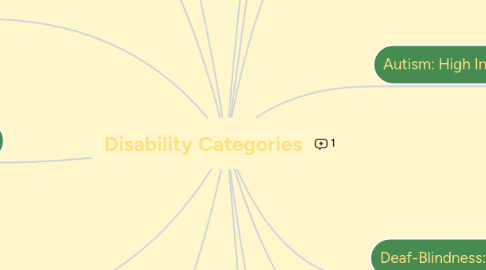Disability Categories
저자: Keisha McGee


1. Emotional Disturbance: High Incidence
1.1. 1. https://www.youtube.com/watch?v=YeEKQC3FIfQ
2. Developmental Delay: High Incidence
2.1. 1. Physical Development
2.2. 2. Cognitive Development
2.3. 3. Communication
2.4. 4. Emotional/Social Development
2.5. 5. Behavioral Development
3. Intellectual Disability: High Incidence
3.1. 1. Deminished intellectual ability
3.2. 2. Deficits in adaptive behavior
4. Multiple Disabilities: Low Incidence
4.1. 1. Simultaneous Impairments that does not include deaf-blindness
4.2. 2. https://www.youtube.com/watch?v=DhCDtFE8JMQ
5. Orthopedic Impairment: Low Incidence
5.1. 1. Congenital Anomoly
5.2. 2. Diseases
5.3. 3. Other Causes
6. Other Health Impairment: Low Incidence
6.1. 1. Acute or Chronic Health Problems
6.1.1. 1. Asthma
6.1.2. 2. ADD/ADHD
6.1.3. 3. Diabetes
6.1.4. 4. Epilepsy
6.1.5. 5. Sickle Cell Anemia
7. Traumatic Brain Injury: High Incidence
7.1. 1. Caused by an external force
7.2. 2. https://www.youtube.com/watch?v=qIA5MVvYBuo
8. Visual Impairment, Including Blindness: Low Incidence
8.1. 1. Difficulty seeing even with corrective lenses
9. Autism: High Incidence
9.1. 1. Student has issues with verbal and nonverbal communication.
9.2. 2. Lack of social interaction with others
9.3. 3. Repetative activiities
9.4. 4. Resistance to change
9.5. 5. Unusual responses to sensory stimulus
10. Deaf-Blindness: Low Incidence
10.1. 1. Simultaneous hearing and visual impairment
10.2. 2.https://www.youtube.com/watch?v=hSmNg2WGXeQ
11. Deafness: Low Incidence
11.1. 1. Hearing impairment
11.1.1. a. Impedes linguistic information processing
11.1.2. b. With or without a hearing aide device
12. Hearing Impairment: Low Incidence
12.1. 1. Flucuating or permanent hearing loss
12.2. 2. https://www.youtube.com/watch?v=nCKAJ_H0rPw
13. Specific Learning Disabilities: High Incidence
13.1. 1. Basic psychological processes
13.1.1. a. understanding or in using language
13.1.1.1. i. spoken or written,
13.1.2. b. imperfect ability
13.1.2.1. listen, think, speak, read, write, spell, or to do mathematical calculations
13.1.3. c. perceptual disabilities, brain injury, minimal brain dysfunction, dyslexia, and developmental aphasia

